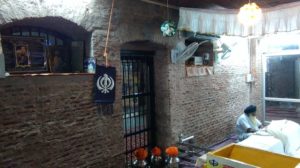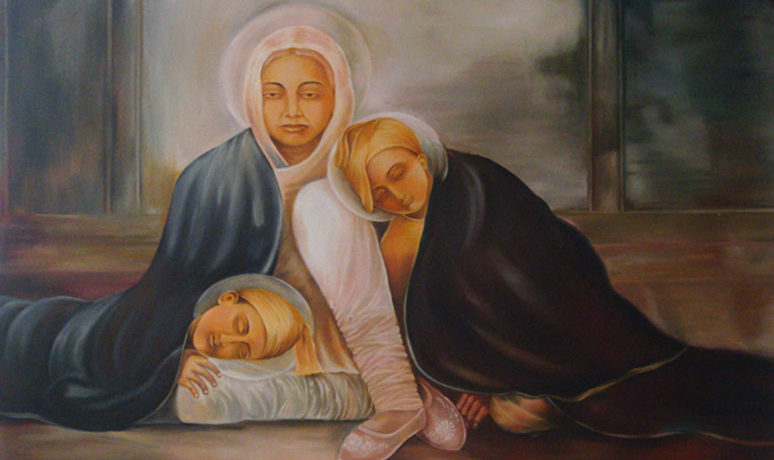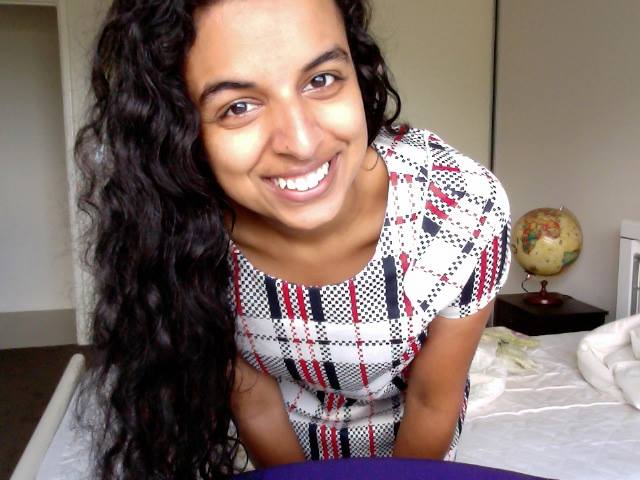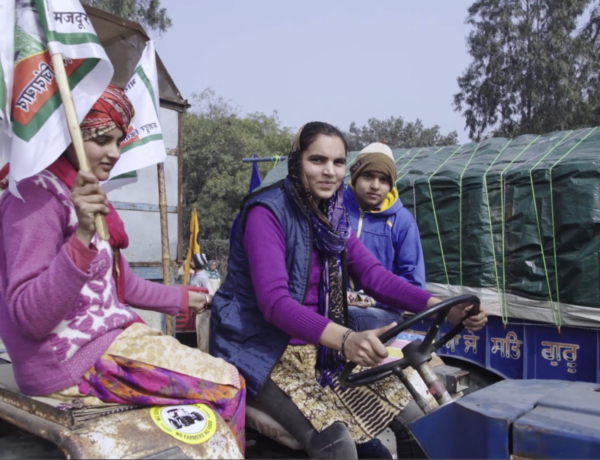By Lakhpreet Kaur
Content note: Violence against the elderly and children.
I thought I was familiar with the story of Mata Gujri Kaur and Shoteh Sahibzadeh. We’ve all heard the traditional story of their capture by the Mughals, tower imprisonment, and being bricked alive for not converting to Islam. But it turns out that is not the full story; I had been told a sanitized, whitewashed version of the story. This weekend at gurdwara, on the anniversary of their shaheedi my dad, Dr. Mohan Singh Dhariwal, relayed the untold history of Mata Gujri and the Shoteh Sahibzadeh. I was shocked. Here’s what his research uncovered…
In 1705, Hindu Hill Chiefs and Mughal troops, who were hostile towards Sikhs, held the town of Anandpur Sahib under siege for several months during which many battles ensued. Eventually, the Mughals offered the Sikhs a peace treaty. The Mughal emperor Aurangzeb wished to meet with Guru Gobind Singh Ji and thus granted him and his Sikhs safe passage to the town of Kangar for a meeting. On December 20-21, 1705 (6-7 Poh, Sambat, 1762) the Sikhs evacuated Anandpur Sahib as per the treaty requirements. However soon thereafter, Aurangzeb’s generals along with the Hindu Hill Chiefs broke the treaty and attacked the Sikhs near present day Majri, Punjab. During the battle, Mata Gujri* along with Guru Gobind Singh’s two younger sons, Baba Zorawar Singh Ji (age 9) and Baba Fateh Singh Ji (7) were separated from the main group at the edge of the Sarsa River.

Mata Gujri and the Shoteh Sahibzadeh went on foot to the town of Chak Dhera where they spent the night at Kumma Mashki’s hut and ate their last meal provided by Brahmani Lashmi. (Kumma Mashki, a ferry operator and water carrier, was Muslim by birth and a supporter and ally of the Sikhs). It is unclear how or when Brahmin Gangu** met up with Mata Gujri and the Shoteh Sahibzadeh, but the next day he took them to his house in the town of Saheri. Instead of helping Mata Gujri and the Shoteh Sahibzadeh, Gangu quickly betrayed them; he stole Mata Ji’s valuables and then turned her and the Sahibzadeh over to Jani Khan and Mani Khan, local Mughal authorities in the town of Morinda. Here, they were put in kotwali (jail). (This building and holding room still exist in Morinda.) In Mughal custody, the Sahibzadeh were tortured in an attempt to convert them to Islam. When they refused to accept Islam, they were taken to the town of Sirhind and turned over to Nawab Wazir Khan, the regional Mughal ruler.
According to Bhai Duna Singh Hindoria (Guru Gobind Singh Ji’s contemporary and documentarian), to transport the Sahibzadeh 25 km from Morinda to Sirhind, the Mughals bound the Sahibzadeh’s hands and feet, stuffed them into sacks, and tied them to the sides of a horse. Mata Gujri’s hands and feet were also tied, and a large, inverted clay pot lined with hot chili peppers was placed over her head and face.
In Sirhind, Mata Gujri and the Sahibzadeh were locked in a tahnda burj (cold tower) which was designed for the nawab’s (regional ruler) summer months. Its design was similar to an elevated gazebo which would have been very cold in the winter with the North winds blowing down from the Himalayan mountains; it would have been particularly cold for Mata Gujri and the Sahibzadeh as they were imprisoned presumably, with little to no clothing.
The next day, the Sahibzadeh were presented before Nawab Wazir Khan. Arriving at court, they were instructed to go through a small door; a guard went in first with his head bowed. The Sahibzadeh, instead of lowering their heads to enter which would have signaled submission, they entered feet-first and greeted Wazir Khan with “Waheguru Ji Ka Khalsa, Waheguru Ji Ki Fateh.” Looking to gain favor with Emperor Aurangzeb, Wazir Khan tried to convert them to Islam by promising massive rewards and riches. But the Sahibzadehs’ repeated refusal led the authorities to torture the Sahibzadeh for the next two days. The Sahibzadeh were whipped with thin mulberry branches. Their hands were doused with kerosene and lit on fire. They were tied to a tree and stoned with sling shots during which Zorawar Singh lost an eye. Through all this, the Sahibzadeh remained resolute in their Sikhi.
During one of the nights Moti Ram Mehra, a devotee of Guru Gobind Singh Ji, decided he would risk giving milk to the Shoteh Sahibzadeh and Mata Ji. He climbed a tree adjacent to the tahnda burj, lowered himself into the tower, and gave them warm milk. Unfortunately, he was caught by the Mughals who put him, his wife, his children, and his mother to death by pressing them through a kohlu (stone grinder).
During the time Mata Gurji and the Shoteh Sahibzadeh were in Mughal custody, the court was divided over the ethics of the execution. For instance, Sucha Nand was supportive of their execution whereas, the Nawab of Malerkotla, Sher Mohammad Khan, was against it and wrote to Aurangzeb citing that Sharia (Islamic Law) opposed taking the lives of children. His argument was dismissed.
The last attempt to convert the Sahibzadeh to Islam was by bricking them alive. Despite repeated attempts however, the wall kept falling. Finally, Mughal executioners Shashan and Bashan Baeg threw the Sahibzadeh on the floor, knelt on the Sahibzadeh’s chests, and slit their throats, in the fashion of zabiha or dhabihah (the prescribed method of ritual slaughter in Islam). Zorawar Singh died quickly but Fateh Singh took adhee ghari (about 13 minutes) to die, as his feet quivered during that time.
After this, the Mughals most likely threw Mata Gujri off the tower to her death, at the age of 81. (It is difficult to believe that Mata Ji died by suicide, as some writers suggest, given her strong commitment to the Sikh cause and her unwavering faith.)
Todar Mal (a wealthy jeweler) and devotee of Guru Gobind Singh Ji, wanted to claim the bodies of the Sahibzadeh and Mata Gujri for cremation. The authorities would only allow him to do so if he was able to pay for the land needed for the cremation. The price: the amount of gold coins it took to cover the required land, placed vertically. Although this rendered Todar Mal’s family bankrupt, he was able to perform the final Sikh rites for Mata Gujri and the Sahibzadeh.***
That is the account I heard at gurdwara this past weekend.
It is the story of valor, grit, faith, and commitment to one’s beliefs, to human rights, and to the development of a sovereign Sikh nation.
I find this version of Mata Gujri and Shoteh Sahibzadeh’s shaheedi to be far more compelling and moving than the more common narrative. The Sahibzadeh simply didn’t just refuse to convert to Islam, but endured barbaric torture, making their strength and conviction far more impressive. Hearing the complete story made me feel more connected to my history and more empathetic to Mata Gujri and the Sahibzadeh’s plight.
Their legacy and the stories of many other Sikhs who sacrificed their lives need to become part of our collective Sikh psyche so that we can continue the sangharsh (struggle) for a true sovereign panth. To do so we need to remember our history.
By Lakhpreet Kaur
Notes
*Born in 1624, Mata Gujri (also known as Gujar Kaur) was one of the first Sikh women to accept Amrit in the 1699 Vaisakhi. She was the wife of Guru Tegh Bahdur Ji and the mother of Guru Gobind Singh Ji. When Guru Tegh Bahadur Ji was killed in 1675, Mata Gujri helped guide the panth along side Guru Gobind Singh Ji.
**Gangu is often described as Guru Gobind Singh Ji’s cook. However, this is historically contested. Gangu was one of the Hindu Kashmiri Brahmins who asked Guru Tegh Bahadur Ji for protection against the Mughals. He then settled in Anandpur Sahib. Principal Satbir Singh wrote that Gangu was hot headed and thus, people named him “rasoi” or “kitchen” because he was “hot”: Gangu Ram Rasoia. From this nick name, people came to believe he was a cook. Although, there is a possibility that he actually was a cook. After the 1699 Vaisakhi, all of the langar was prepared by the Khalsa so, if Gangu was a langari (langar sevadar), he no longer was after Vaisakhi. It is also likely that Guru Gobind Singh Ji did not have a special, separate cook, but ate the same langar that was prepared for the sangat.
*** While every effort was made to ensure that the information in this article is correct and error free through referencing multiple source, there still may be unintentional errors or omissions. Bhul chuk maaf. If you have any resources, please let us know.
Sources:
- “A History of Sikhs, Volume 1” by Kushwant Singh (book)
- “Bansavali Nama” by Kesar Singh Chibber (book)
- “Chaar Sahibzade Untold Story,” by Dr. Sukhpreet Singh Udhoke (film)
- Diwan Todar Mal (web entry)
- Gurdwara Kotwali Sahib, Morinda, Ropar, Punjab (film)
- Gurdwara Sri Kotwali Sahib (website)
- Gurdwara Yadgar Saah Baba Kuma Maskhi Chak Dhera (web entry)
- “Katha Gur Sutan Kee Granth” by Bhai Duna Singh Hindoria. Giani Pinderpal Singh, Dr. Sukhpreet Singh Udhoke, and Principal Satbir Singh both refer to Bhai Duna Singh Hindoria as Guru Gobind Singh Ji’s contemporary and documentarian. His historical manuscript, “Katha Gur Sutan Kee Granth,” was allegedly burned in the 1984 Battle of Amritsar. However, Professor Piara Singh Padma made a copy of it before it was destroyed.
- “Leaving Anandpur Sahib,” by Singh Station (blog post)
- “Nawab Sher Mohammad Khan’s Plea,” by Preet Mohan S Ahluwalia (web entry)
- “Sahibzadeh,” by Devinder Singh at Khalsa College (film)
- “Sikh Shaheed Itihaas,” by Giani Pinderpal Singh (film)
- “The Sikh Religion, Vol V & VI,” by Max Arthur MaCauliffe (book)
- “Zafarnama,” by Guru Gobind Singh Ji (document)
- Zorawar Singh & Fateh Singh (web entry)
Feature Image: Mata Gujri & Chote Sahibzade hand painted replica by Charanjit Kaur via the Sikh Foundation.





5 Comments
JAGWINDER SINGH SIDHU
12/30/2016 at 2:49 amTy very nice story. We need a Bible like book that tells all of our history concisely.
jasbir
12/30/2016 at 3:48 amGangu belonged to village Kheri, where his family lived. More important thing is not bravery, valor but they sacrificed their lives for us,. Their sacrificed helped us to pass through the trouble period and remove cruel mughal empire. Their sacrifice gave sikhs a reason to fight. ਹਮ ਕਾਰਨ ਗੁਰ ਕੁਲਹਿ ਗਵਾਈ॥ ਹਮ ਕੁਲ ਰਾਖਹਿ ਕਵਨ ਵਡਾਈ ॥ Thanks for the good article.
Gurmukh Singh UK
12/30/2016 at 4:06 pmAs I research and write about the much-misrepresented life of Guru Tegh Bahadur ji as an opt-out recluse before Guruship, “Life and Unique Martyrdom of Guru Tegh Bahadur”, I am convinced that Mata Gujri ji was the greatest Sikh woman of all times.
A History of Sacrifice, Remembrance, and Courage
07/19/2018 at 9:11 am[…] those who want to read more about the sacrifices of the sahibzaade and Mata Gujar Kaur, read the Kaur Life article on their […]
Harminder K
12/26/2021 at 7:10 amAmazing Sacrifice, Kurbani.. just so heart wrenching.. Dhan DHAN Chaar Sahibzaday, Dhan Mata Gujar Kaur Ji! Dhan Dhan Guru Gobind Singh Sahib Maharaj Ji! 🙏